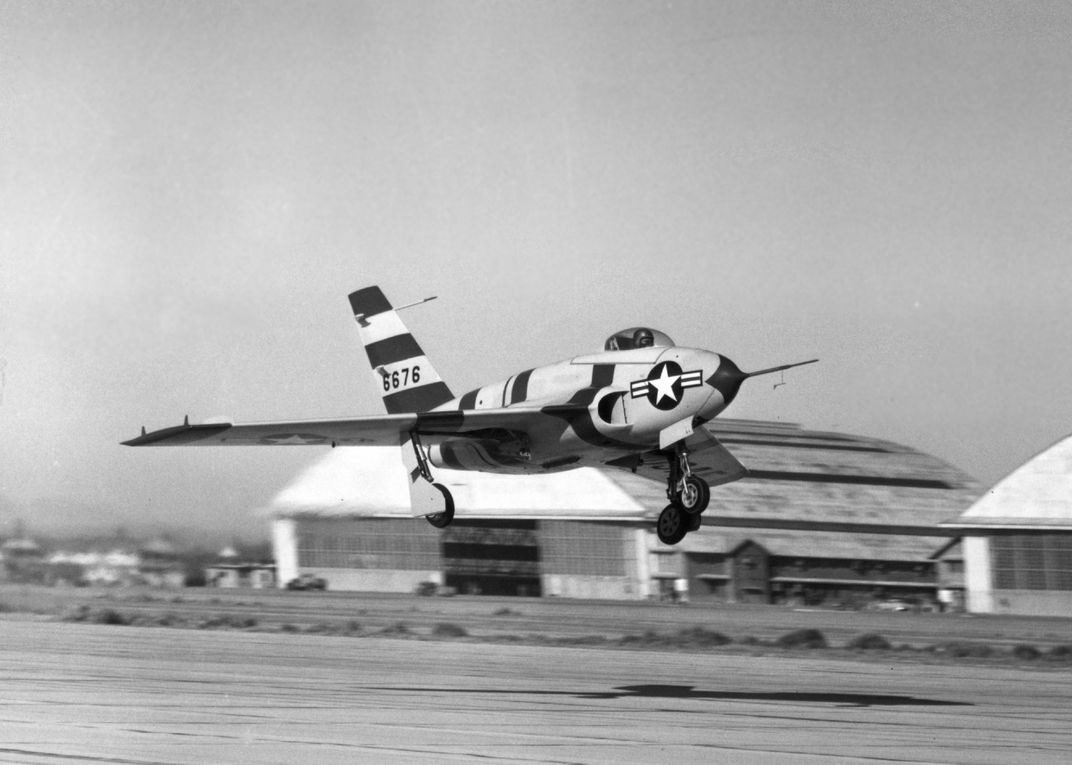The 98-Pound Weakling of Research Airplanes
Maligned and abandoned, the prototype Northrop X-4 Bantam gets a restoration after 65 years.
/https://tf-cmsv2-smithsonianmag-media.s3.amazonaws.com/filer/cb/80/cb8092a9-d923-4d6a-8ab1-9bbbff37111f/14b_am14_northrop_x-4_live.jpg)
When it appeared at the flight test facility at California’s Muroc Air Force Base in 1948, the Northrop X-4 Bantam was the 98-pound weakling of research airplanes. The X-1 and X-2 rocketplanes were the big bullies, punching through the Mach left and right, and even the extreme but useless Douglas X-3 Stiletto was at least able to pose on the ramp looking like Marty McFly’s prom ride. The swing-wing X-5 would soon arrive and prove to be Steady Eddie—one of the few X-planes to complete every test planned for it. The nerdy little X-4, however, couldn’t even sneak through the sound barrier.
In Yeager: An Autobiography, Chuck Yeager wrote that before Air Force test pilots even got into the X-4, Northrop pilot Charles Tucker “got her out to .93 Mach, when she began to spin violently. We figured that she would punch a hole in the desert, so we quit right there and junked her.” Yeager was recalling the first X-4, and that airplane indeed was ill-built and mechanically flawed. The second of the two X-4s, however, flew 82 missions, and none of its pilots, including Yeager, had a serious incident or accident. Today, it sits in the National Museum of the U.S. Air Force, near Dayton, Ohio.
So what became of the lame duck that preceded it? After decades of outdoor display at the Air Force Academy in Colorado Springs—where, being smaller than a Cessna 152, it was the frequent object of midnight-mover pranks—the Air Force recently retrieved the maligned prototype and restored it. It is now on display at the Air Force Flight Test Museum at Edwards Air Force Base in California.

The restoration was largely cosmetic: The airplane was simply disassembled, cleaned, and repainted. There’s nothing left of the two little Westinghouse J30 turbojets that were once in the fuselage, and the incomplete cockpit is hidden below a canopy, which had to be painted over because the Plexiglas was crazed after years of exposure to the Colorado sun. The cockpit once contained sandbags to weigh down and stabilize the airplane; the bags eventually deteriorated and burst, spreading sand everywhere. Cleaning it out of the nooks and crannies was one of the most wearying parts of the restoration.
The X-4 was built because researchers wanted to know if eliminating a large part of an airplane’s empennage—the horizontal tail—would help make an airpane break the Mach. In theory, losing the horizontal tail results in less wetted area (the area in contact with the airflow) and thus less parasite drag. Since the airframe didn’t have to support the forces imparted by what was essentially a small wing, it could also be lighter and smaller. Jack Northrop, a flying-wing visionary, was the leading American proponent of this theory. He was likely inspired by Alexander Lippisch, a German fan of tailless aircraft who had designed the Messerschmitt Me 163, a World War II rocket interceptor that resembled the X-4.
Tailless designs have a particular benefit for supersonic flight. Horizontal tails produce shock waves. On a horizontal tail that hasn’t been designed for transonic flight (typically by making it a moving stabilator), the violently disturbed airflow can destroy the tail’s pitch-controlling capability.
The X-4’s primary pilot was Scott Crossfield, who would go on to make pioneering flights in the X-15 rocketplane. According to his memoir, Always Another Dawn, Crossfield was still a newbie when his boss at the National Advisory Committee for Aeronautics, Walter Williams, told him, “It’s a little tricky to fly. The engines flame out at altitude. She pitches a bit at Mach .9. British lost a couple of de Havilland Swallows of similar design. Mystery why they crashed. Maybe we can find out with this baby.”
Despite the welcome-to-doomsday introduction, Crossfield flew the X-4 32 times. “At Mach .88 the plane became unstable,” he told Clay Blair Jr., his Always Another Dawn co-author. “It broke into a steady porpoising motion, like an automobile cushioning over a washboard road...nearer the speed of sound, no one knew what would happen.”
Crossfield found out what would happen. On September 22, 1952, he pushed the X-4 to Mach .94, the fastest it ever flew. “The pitch oscillations diminished in amplitude [size] but increased in frequency.” Worse, the X-4 became unstable not only in pitch but in roll and yaw as well. For control, the aircraft had to depend on its wing alone, which had combined elevator and aileron control surfaces, called elevons.
The X-4 did what it was designed to do: It answered the question “Will tailless supersonic airplanes be the next big thing?” More than six decades later, the idea still hasn’t panned out. The Northrop Grumman B-2 flies without tails, but it can’t bust the Mach.